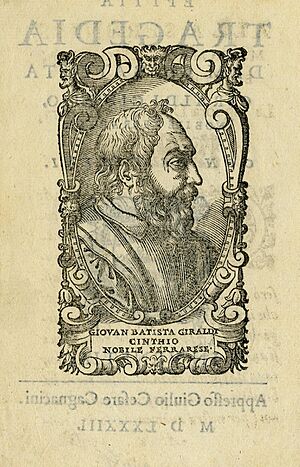Giovanni Battista Giraldi facts for kids
Giovanni Battista Giraldi (born November 1504 – died December 30, 1573) was a famous Italian writer. He wrote many novels and poems. People often called him Cinthio (pronounced CHIN-tee-oh). This was a nickname he added to his name.
Contents
About Cinthio's Life
Cinthio was born in a city called Ferrara in Italy. At that time, Ferrara was the capital of a small state called the Duchy of Ferrara. He studied at the University of Ferrara.
In 1525, Cinthio became a professor there. He taught about natural philosophy, which was like early science. Twelve years later, he took over teaching belles-lettres. This subject included literature and writing.
Working for Important People
From 1542 to 1560, Cinthio worked as a private secretary. He first worked for Ercole II and then for Alfonso II d'Este. These were important rulers in Ferrara.
However, Cinthio had a disagreement about literature. This made him lose favor with his boss. So, he moved to a town called Mondovì. He taught literature there until 1568.
Later, the city of Milan invited him to teach. He became a professor of rhetoric (the art of speaking and writing well) at Pavia. He stayed there until 1573. Cinthio then returned to Ferrara because he was not well. He passed away there later that year.
Cinthio's Writings
Cinthio wrote many different kinds of works. He wrote an epic poem called Ercole (published in 1557). This long poem had twenty-six parts, called cantos.
He also wrote nine tragedies. A tragedy is a serious play with a sad or terrible ending. His most famous tragedy was Orbecche. It was first performed in 1541. This play was very intense and dramatic. Many people thought its powerful poetry made up for its dark themes.
New Ideas in Theatre
Cinthio's plays were influenced by the Catholic Reformation. This was a time when the Catholic Church was making changes. His plays tried out new ideas. These ideas later became common in modern European theatre. For example, they influenced the Elizabethan theatre in England. This was the time of Shakespeare. They also influenced the baroque style, which used strong emotions and drama. Cinthio's plays often used psychological tension and horror. They also showed events happening in real time.
His Famous Collection of Stories
One of Cinthio's most important prose works is Hecatommithi. This title means "A Hundred Tales." It is a collection of stories. It is similar to the famous stories by Boccaccio. It is also like the novels by Cinthio's friend, Matteo Bandello.
Cinthio's stories aimed to show higher moral standards. The Hecatommithi was first published in 1565 in Mondovì. It was reprinted many times in Italy. A French translation came out in 1583. A Spanish version with 20 of the stories was published in 1590.
Connection to Shakespeare
These stories are very interesting for students of English literature. This is because they provided the plots for two of Shakespeare's famous plays. These plays are Measure for Measure and Othello.
The story for Othello is found in the Hecatommithi. Shakespeare likely read it in the original Italian. The story for Measure for Measure probably came from a play by George Whetstone. Whetstone adapted Cinthio's story in his play Promos and Cassandra (1578). He also included a direct English translation in his Heptamerone (1582). Cinthio's stories also inspired the play Custom of the Country by Beaumont and Fletcher.


